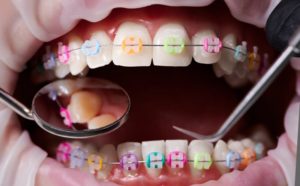
After you have had traditional braces for 4-6 months, your orthodontist might tell you it is time to start using rubber bands which are also known as elastics. It is understandable if you feel a little frustrated because now you have yet another component of treatment to think about, but you can be certain that your orthodontist in Palm Harbor would not advise you to use them unless absolutely necessary. This post discusses the critical role of rubber bands on braces, and it provides some guidance on what you can expect while wearing them.
The Role of Rubber Bands on Braces
Braces use brackets and wires to apply pressure to the teeth. Over time, that pressure shifts the teeth into their proper positions. However, the brackets and wires by themselves are not always enough to produce the desired results. Rubber bands can be hooked onto the brackets to put extra pressure on the teeth, thereby encouraging accurate and efficient tooth movements.
Rubber bands on braces also play a key role when it comes to addressing malocclusion (bite problems). The goal is to get your top and bottom teeth to fit well together when your mouth is closed. Sadly, many people struggle with an overbite, underbite, crossbite, or similar problem. Rubber bands can help train the lower jaw to rest in its proper position. As a result, your bite should improve, and you should enjoy enhanced oral function. There are also aesthetic benefits to correcting bite issues; your facial profile could improve.
Adjusting to Rubber Bands on Braces
Orthodontic rubber bands are designed to be as comfortable as possible, but they can still cause a degree of soreness. When you experience discomfort, resist any temptation to remove the rubber bands. Taking them off for an extended period can lead to a repeat of your discomfort when you finally put them back on. Complying with your treatment instructions will help any pain to dissipate as quickly as possible.
You should try to wear the rubber bands for 23 hours a day, removing them only at mealtime and when you clean your teeth. At first, it might be a little challenging to incorporate them into your routine. However, most patients adapt fairly quickly.
If you ever run into any questions or concerns about how to use your rubber bands, ask your orthodontist for advice. They will be happy to guide you as you navigate all the aspects of your orthodontic treatment.
Rubber bands are often an important part of braces treatment. Use them as directed to avoid unnecessary complications during your journey to a healthier, straighter smile!
About the Author
Dr. Alex Johnson earned his dental doctorate from Washington University and stayed to attain his orthodontic certificate as well. He is a member of the American Association of Orthodontists and has completed continuing education courses at the prestigious Pankey Institute. Dr. Johnson offers traditional braces that deliver time-tested results, and he will be happy to further discuss the role of rubber bands in this treatment. Schedule a consultation on his website or call (727) 786-7550.
